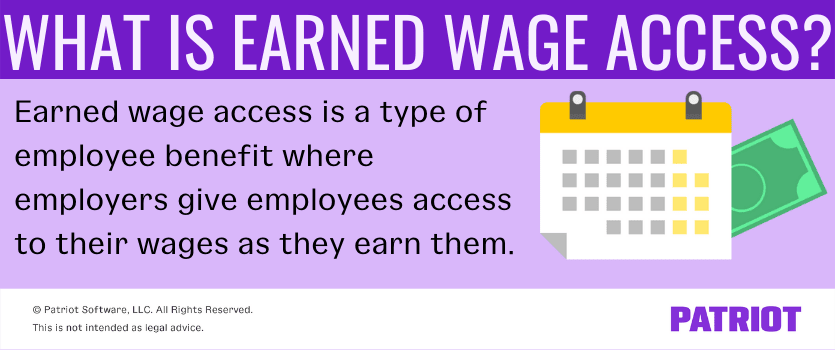The digital age has brought with it a slew of new technologies and advances. From cryptocurrency to digital wallets to blockchain, people are experiencing newer and faster ways of living than ever before. Another advance employers should keep an eye on is earned wage access. Keep reading to get the scoop on what earned wage access is, how it works, and more.
An overview of earned wage access
What is earned wage access, exactly? Earned wage access (EWA) is an employee benefit where employers give their employees access to their net earned pay as the employees earn it. Basically, employees can access their earned wages before their employer-designated payday.
Also known as early wage access, instant pay, earned income, or on-demand pay, EWA gives employees early access to their net pay earnings.

When employees access their net pay before their regular pay date, the wages they access are deducted from the total earnings they’d receive on pay day. Say an employee typically receives $1,000 every two weeks but opts to receive $200 before their next payday. On their typical payday, they would receive $800 ($1,000 – $200).
There are currently no federal laws regarding earned wage access. Some states (e.g., New Jersey) have proposed or passed EWA laws. Check with your state for more information on EWA laws for employers.
How does earned wage access work?
Earned wage access typically works by pairing financial technology providers with a company’s HR technology. In many cases, HR and payroll departments use an app that integrates with their payroll software. The app then makes the employees’ net wages available to them automatically.
By integrating with payroll software, the financial app for EWA lets employers make any and all necessary payroll deductions before sending the funds to employees. By deducting taxes before funds are available to employees, employers can ensure that they have the funds they need to remit to the proper tax authorities.
Earned wage access providers use specific software that is tailored to the process. If you decide to offer EWA to your employees, check with your current payroll software provider to see if you can integrate. Don’t use payroll software? Check with EWA providers to determine if your payroll process is suitable for EWA.
Keep in mind that some early wage access providers limit the amount of money employees can receive between standard paydays. For example, some providers may restrict available funds to 50% (0.50) of an employee’s total paycheck. An employee who earns $1,000 every two weeks would only be able to access $500 between paydays ($1,000 X 0.5).
Pros and cons of early access to earned wages
Before you sign up to give employees access to earned wages early, learn the benefits and drawbacks of EWA.
Benefits of EWA
As many as 54% of Americans live paycheck-to-paycheck. EWA allows employers to access earned wages, which alleviates part of the burden of living paycheck-to-paycheck. The benefits of offering wage access to your employees relate to improving employee livelihood.
Pros to earned pay include:
- Higher employee retention
- Reduced financial stresses for some employees*
- Increased employee satisfaction
- Higher attendance rates among employees
*Employees may face financial stress because they must make a paycheck last between paydays. They may seek a second job or payday loans with high interest rates.
When employees are more satisfied with their jobs and less stressed with their finances, they perform better. On-demand pay aims to achieve those goals. As a result, employers benefit from giving employees early access to their wages. How? Better performance, higher retention, and employee satisfaction keep businesses running and save employers money by reducing employee churn. And, employers save money by not having to hire and train new employees.
Brian Nagele, CEO of Restaurant Clicks, said that the benefits of offering EWA are especially timely:
Earned wage access is ideal for businesses hoping to attract more full-time employees, especially amidst the Great Resignation. Many companies are struggling to onboard and retain employees, partly due to the increased popularity of the gig economy. Offering real-time access to salaries allows businesses to mimic one of the perks of remote work — freedom in payment schedules. It’s a great strategy to prove to prospective employees that you value their needs and are willing to compromise for their human resource.”
Cons of EWA
Unfortunately, early wage access is still a new concept. So, many of the beneficial claims to offering EWA are not statistically significant yet. Without knowing the long-term benefits of EWA, the proposed benefits could be a drawback down the line.
Other cons of on-demand pay include:
- There are limited providers for early wage access technology
- Laws and regulations may limit or change how employees can receive early pay
- EWA providers may charge employees to access funds
- Potential data leaks in wage access software can compromise employee information
- Employer fees for using the program may be high
Essentially, finding the right provider that won’t cost your employees money and safeguards their personal information can be a time-consuming process. Weigh the pros and cons carefully before making early pay available to your employees.
How to create an early wage access policy
If you decide to offer early pay to your employees, you must do your due diligence first. Research providers thoroughly. Ask questions like:
- What are the employer fees for using early wage access software?
- Does the software integrate with your current payroll system?
- How much will employees be charged to use EWA?
- What are the state laws regarding EWA?
When you know the answers to these questions, compile the information for your employees. Consider adding an employee benefits form for on-demand pay to your employee paperwork. Give employees the option to enroll or decline the benefits.
Here are some sections you may add to benefits enrollment paperwork for early pay:
- Name of the provider
- Instructions for enrolling, if applicable
- Fees for using early pay
- Limits to the amount employees can receive, if applicable
- Opt-in or out process
Keep signed paperwork in each employee file for future reference.
This is not intended as legal advice; for more information, please click here.
